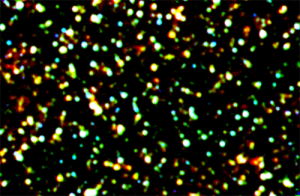| Basic Information | |
| What is this? | A view of thousands of distant galaxies, in a patch of sky called GOODS-South |
| Where is it in the sky? | In the constellation of Fornax |
| How big is it? | The image is about a tenth the size of the Full Moon |
| How far away is it? | The galaxies are at different distances, see as they were between 3 and 10 billion years ago. |
| What do the colours represent? | Red galaxies are either cooler or more distant, while blue galaxies are either warmer or closer to us |
Downloads
See this object in:
Astronomers using the Herschel Space Observatory have shown that very distant galaxies were not so different from those seen locally. The most distant galaxies, which we see at a point when the Universe was only a few billion years old, tend to be much more luminous than those we see around us today.
Studying these distant galaxies can tell us what our own Galaxy used to be like, explained Professor Rob Ivison, of STFC’s UK Astronomy Technology Centre in Edinburgh. “It’s the closest thing we have to looking into our own past. The formation of stars generates large amounts of light, but along with that energy comes colossal quantities of cosmic dust. This means that most of the brilliance of these galaxies is obscured from view in the optical wavelengths to which our eyes are sensitive.

Instead, astronomers use infrared telescopes to look at the light emitted by the dust itself, and it is at these wavelengths that distant galaxies really shine. “These regions have been observed extensively by our best telescopes, from radio waves to X-rays, from the ground and from space,” explained Prof Ivison. “By studying the far-infrared light using Herschel’s SPIRE and PACS cameras we have now been able to measure how much star formation is hidden behind clouds of cosmic dust.” The image above is of the GOODS-South region, one of the regions used for this study. The other is its counterpart in the northern hemisphere, GOODS-North. Taken together these regions are smaller than the size of the Full Moon as seen from Earth, but they contain many thousands of galaxies.
In today’s Universe, galaxies associated with intense, compact bouts of star formation are called “starbursts”. They are distinguished from much calmer galaxies like our own Milky Way, where stars form out of the relatively undisturbed interstellar gas and dust distributed throughout the Galaxy. The starburst galaxies are rarities, triggered when the gas within them is stirred up by collisions with other galaxies. In the cramped confines of the early Universe, starbursts were expected to be more common, but all attempts to use them to explain away the distant galaxies’ brightness were doomed to failure.
It was found that the early galaxies were converting their supplies of primordial gas in a similar way to the Milky Way, with the action spread over quite large volumes of space. Their brightness is due to the huge supply of gas available in these early galaxies, which allowed them to form stars at a much faster rate. This allows astronomers to explain all the observations accurately, and without the need for the troublesome galactic collisions.
“Understanding the way stars were formed in these much earlier eras of the Universe is crucial to understanding the Universe around us today, since most of the stars we see were formed between 3 and 10 billion years ago”, commented Professor Dave Alexander of Durham University. “These new revelations are telling us more about the conditions in which stars like our Sun formed, and helping us to compare those with to the environments in which stars are forming today”.
Professor Matt Griffin, of Cardiff University and lead scientist of the SPIRE instrument on board Herschel, said “these two regions of sky have already been studied in great detail by many of the world’s most powerful telescopes, yet the Herschel Space Observatory has made another ground-breaking discovery”.
Detailed Information
GOODS-Herschel

